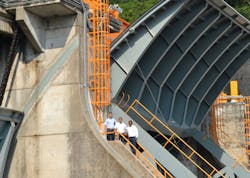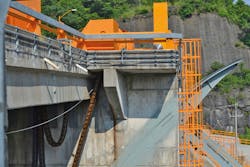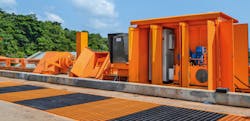Hydraulic Motors Give Mexican Dam a Big Lift
This file type includes high resolution graphics and schematics when applicable.
A crane with a huge iron plate on its hook stands on the dam wall at Nezahualcóyotl Lake in southern Mexico. The crane operator carefully lowers it into the lake in front of a spillway gate in the dam. The water mass of the lake pushes the plate against the concrete wall as the plate slowly descends, closing the opening. The spillway gate then opens, and the water between it and the iron plate drains off. The spillway gate—which usually prevents the dam from overflowing—is now dry, so workers can now inspect the area.
Manuel Schuhmann, technical project manager at Bosch Rexroth, is enthusiastic: “It is fascinating: The plate, or the so-called stop lock, is held in place solely by the reservoir’s water pressure.” The task of the engineers is to modernize the old drives on the dam’s spillway gates.
Cautious Innovation
Built between 1958 and 1966, the 138-m-high dam, which is officially known as the Nezahualcóyotl Dam, holds back a lake with more than 10 million m3 of water and a surface area of about 110 km2. The dam protects the lowlands of the Federal State of Tabasco against yearly flooding and also contains six turbines, which generate hydroelectric power for the region.
The Comisión Federal de Electricidad (CFE) operates the dam and invests regularly in the safety and availability of all its technical equipment. Last year the Comisión decided to modernize three of the dam’s seven spillway gates, which regulate the water level of the reservoir. Each spillway had an electric motor driving two pinion gear drives via a drive shaft. The motor had been raising the 170-ton spillway gate using chains on each side ever since the dam went into operation in the 1960s.
Martín Gómez, project manager at Bosch Rexroth in Mexico, recalls the CFE’s invitation to tender for this project: “We initially proposed a solution with long-stroke hydraulic cylinders to drive the gates.” The team had already used this proven type of drive in new construction many times—such as the La Yesca Dam, also in Mexico. However, the concrete structure at the Malpaso Dam proved to be unsuitable.
Without reinforcement, the wall could not withstand the forces of the cylinders. And converting the concrete structure would have been a lengthy and complex process. “So we developed a solution that uses the existing chain hoist,” Gómez explains, “but with all the advantages of hydraulics.” Schuhmann adds, “In steel construction for hydraulic engineering, the most important factor is safety. When we were able to show that similar hydraulic systems were already being successfully used in other dams, we got the contract.”
Safety First
The Malpaso solution has a hydraulic power unit (HPU) permanently installed in each gate. Each HPU drives two Hägglunds low-speed, high-torque radial-piston motors. These motors, provided by Bosch Rexroth, replace the mechanical gear and drive the chains’ sprockets directly. Gómez explains, “The hydraulic system has natural overload protection. So if, for example, a tree trunk gets wedged in the gate, and the chain load becomes greater than calculated, a relief valve dissipates the pressure to prevent damaging the drive. This scenario would cause a mechanical drive to break down. Our hydraulic solution offers a clear safety advantage.”
As an additional safety measure, the Bosch Rexroth hydraulic engineers mounted a spring-applied, pressure-released disk brake on each motor. The brake lets the system operate as long as it is pressurized. But if operating pressure is lost for any reason, the brake closes automatically with enough force to stop the spillway gate. This ensures maintaining control of the gate even in the unlikely event of power failure.
Easy on the Chains
The new hydraulic drive also protects the chains. The electromechanical drove produced jerky motion when started; it yanked and tugged at the chains before moving the spillway. This not only placed high stress on the chain links, but also on all the mechanical parts involved, necessitating frequent service. “The hydraulic drive, on the other hand, starts up slowly and steadily and gently tightens the chain,” says Gómez. “This considerably reduces the maintenance measures required.”
Bosch Rexroth not only conducted the engineering and installation, but also the electrical control system, including software programming. Schuhmann explains, “Each hydraulic power unit has its own electrical control system. Operators also have the option of controlling all three through a panel. Conveniently, the operator can make adjustments on the touchscreen to open the spillway one meter, for example.” Compared to the buttons and levers, this is a huge improvement in ease of use. The decisive factor, however, lies elsewhere: The spillway now transmits position data to indicate whether it is closed or to what degree it is open. It also transmits water temperature and pressure.
The Bosch Rexroth engineers worked three months and completed the retrofit project in June 2015 where the crane lifted out the iron plates. Three spillway gates now have a new, safer drive, and work began on the remaining four. Schuhmann adds, “We already have inquiries from India, where they want to know more about the hydraulic chain hoist drive. This could be a new standard solution for retrofits!”
For more information on Bosch Rexroth’s Hägglunds radial-piston motors, click here.
This file type includes high resolution graphics and schematics when applicable.





